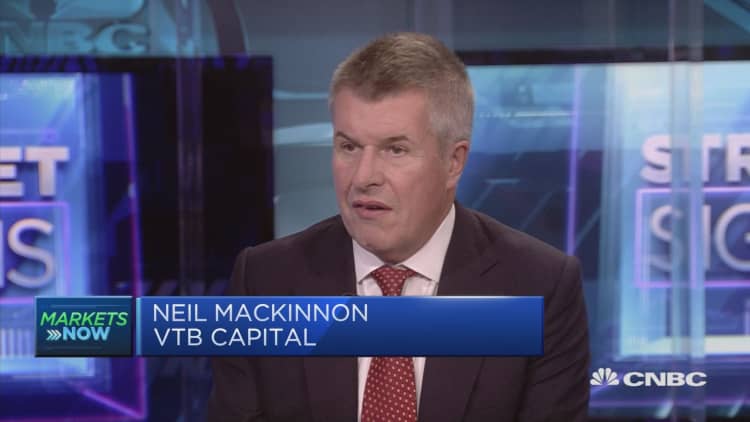
The are some "classic" signs of market bubbles in certain asset classes, according to VTB Capital's Global Macro Strategist Neil MacKinnon, who believes that easy money from central banks is to blame.
"I think what we're seeing across some asset classes is the appearance of bubbles — we're thinking of cryptocurrencies," MacKinnon told CNBC Tuesday, also mentioning the market for fine art. "There are bubbles and I think they arise from ultra-easy monetary policy that has created a speculative excess and excess leverage."
MacKinnon is not alone in this view — many market commentators have warned of the downsides of enduring loose monetary policy, calling for an end to quantitative easing in the face of resurgent global growth.
"There is growing concern among some market commentators, even among central banks, that there is a potential threat to financial stability," he went on. "I think the (Federal Reserve), for example — they are concerned about the risk to financial stability, and they should be."
The Fed has forecast three rate hikes in 2018 while targeting a range of 1.25 percent to 1.5 percent for its benchmark interest rate, inching up from years of historically low rates as economic growth strengthens.
"It could well be that we see more frequent flash crashes, that's for sure. Worst case scenario is an outright market crash — it may come from underneath the radar screen as sometimes they do," MacKinnon said. He ruled out risks in the banking sector, however, noting the sector is well-capitalized and banks have raised their liquidity buffers.
'Stability brings about instability'
Instead, he suggested, the threat may come from historically low volatility. "Many commentators have pointed out that the 'big short' this time around is in Vix volatility," he said, referring to the CBOE's headline index measuring volatility in U.S. equities. The Vix has been significantly below its historic average of 20 for most of 2017. Paradoxically, the apparent comfort level in the markets may actually be a recipe for impending shocks.
"The super low levels of volatility are very vulnerable either to an inflation shock which then brings about an unexpected interest rate shock," MacKinnon stressed. "These low-volatility strategies have created fragility — stability brings about instability."
Others in the market sphere might not have such strong views, though they emphasize that investors shouldn't expect the coming year to be a repetition of 2017.
Deutsche Bank expects the global recovery to continue in 2018, projecting global growth at 3.8 percent compared to 3.7 percent in 2017. However it is warning investors not to assume economic growth will automatically translate into similarly high levels of investment returns in the year ahead. "Forewarned is forearmed" was the first of 10 themes in the bank's new report this week.

Asked about future market risks, Christian Nolting, Deutsche Bank's chief investment officer of wealth management, told CNBC, "In my view, 2018 is probably quite unlikely to see a pure repetition of 2017. We have very nice returns especially for the risky assets, and from a growth perspective we think it's probably continuing."
Still, he noted that central banks are in transition, supporting markets while beginning to withdraw the low-interest rate safety net that's been in place for the past decade. Any interest rate rise deemed too fast, or even too slow, could cause markets to lose trust in the central banks, Nolting said. "There might be risks in the market, that's why we warn not to be too complacent."
Antoine Lesne, head of SPDR ETF strategy at State Street Global Advisors, expressed more optimism based on further growth forecasts. "We think (a) pullback has to happen at some stage, but the reality is that as long as economic expansion continues, or gets a boost from the tax reform, this could be a positive for the equity markets," he said. "But if you want to expect a double-digit return, that might be too much."
Investors should be on their guard, MacKinnon maintained. "I think it's going to be a big challenge for policymakers in 2018, how they handle the appearance of some of these bubble-type conditions as they try and normalize monetary policy."


